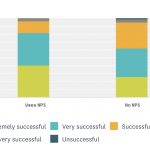Why customer satisfaction is important (and how to focus on it)
Measuring customer satisfaction may not feel like the most important thing on your big to-do list. After all, you have things like revenue numbers, web analytics, and a host of KPIs that tell you how your business is doing. But by giving your customers a voice, you’ll learn what you could be doing better. And you’ll do a much better job of understanding why your big numbers are or aren’t where you want them to be.
Through our research and the work of others, it’s pretty clear that the importance of customer satisfaction can’t be understated. As an example, companies who measure their Net Promoter ® Scores (NPS) are a third more likely to have growth rates over 10% a year:
How successful do you think our company is?

More impressively, the mere act of measuring customer satisfaction has been shown to improve customer retention—even if the feedback is ignored.
So, how can paying close attention to specified satisfaction goals help you? Here are four other tangible ways to help your bottom line by prioritizing customer feedback:
1. Answer important questions
In its Consumer Technographics survey, Forrester found that 45% of US consumers will abandon an online transaction if their questions or concerns aren’t addressed quickly. That’s a huge hit to your business if you’re not meeting customers’ expectations!
The good news is there are two proven ways to anticipate and combat customer satisfaction obstacles like this. The first is to make it easy for customers to get help when they need it. For example, you could prominently display your phone number on every page of your website. Letting potential customers know that they can easily get in touch with a real person will put their minds at ease. The second is to make DIY help resources available. Take time to do things like create a comprehensive FAQ section on your website. By putting answers to the most common questions where customers can find them, it’s possible to simultaneously increase customer satisfaction and reduce your customer support workload.
Of course not every business is a website. Stretching this lesson to different types of businesses, offering your customers help at critical touchpoints can be a key performance indicator. You should also ask existing customers for feedback to help identify times when they were confused or felt underserved.
2. Create a customer-focused culture
According to Bain & Company, a customer is four times more likely to buy from one of your competitors if their problem is service related versus price or product related. By emphasizing the importance of customer satisfaction throughout your entire company, you’ll be able to create a culture that truly puts customers first. Having this type of culture is exactly what’s needed to build a brand that’s associated with great customer service. Since a truly strong brand is very hard to replicate, your company will have a major competitive advantage if you focus on improving satisfaction through employee engagement.
3. Make it personal (and keep costs down)
One of the most common myths about maximizing customer satisfaction is that it will significantly increase costs. However, because it’s six to seven times more costly to attract a new customer than it is to retain an existing customer, prioritizing customer satisfaction can actually help control costs.
Of all the ways to increase customer satisfaction and maximize customer retention, personalization is one of the most powerful strategies. Customers are more likely to be comfortable with businesses who know them and address their needs. Given the fact that it’s easier than ever to manage and use customer information, your company should always be looking for new ways to make every customer feel important, and that what you’re offering is specifically tailored to them.
4. Use loyalty to your advantage
Price insensitivity is a key benefit of loyal customers. But repeat customers aren’t the only ones who are open to paying a higher price for quality. A report published by Defaqto Research found that 55% of consumers would pay more for a better customer experience. What that means is making customer success a top priority may give you a little leeway on price and other places where you could be at a competitive disadvantage. Delivering amazing service to customers makes it possible to actually raise prices and still come out on top of competitors. Good service adds to the value of the product.
So, now what?
Now that you’ve seen the importance of customer satisfaction to your bottom line, it’s time to put this information into action. If you’re ready to start really putting customers first and start understanding consumer purchase intentions, here are some ideas and survey templates to help you take the next step:
Discover more resources

Customer satisfaction survey templates
Explore our customer satisfaction survey templates to rapidly collect data, identify pain points, and improve your customer experience.

See why Together Labs relies on SurveyMonkey for user insights
Discover why Together Labs ditched Google Forms and upgraded to SurveyMonkey Enterprise to collect in-depth user feedback.

Learn how Point of Reference gets the most out of NPS surveys
Discover how Point of Reference uses SurveyMonkey to capture valuable customer feedback, including Net Promoter Score (NPS®).

Ecommerce Payment Form Template
Streamline your online transactions with our Ecommerce Payment Form Template. Secure, easy to use, and customizable to fit your business needs.